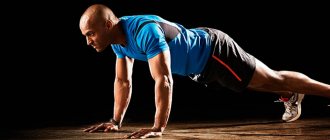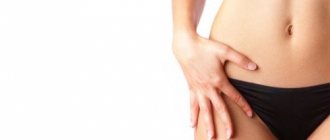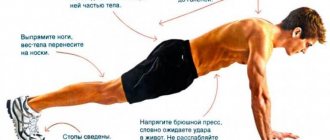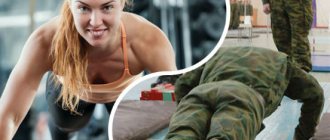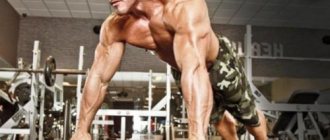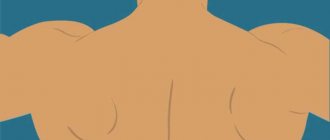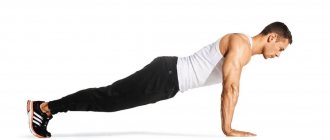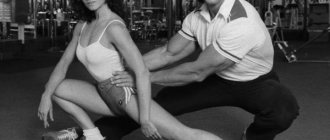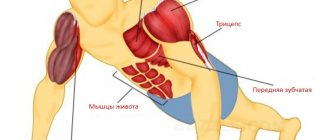How to learn to do 100 push-ups? The most effective 6-week program will help you!
Regardless of your fitness level and current rep count, this program is guaranteed to increase your push-up count by at least 100 times in 6 weeks.
Correct performance of push-ups
Before starting the program, you need to determine your fitness level by doing the maximum number of push-ups. If you have done more than 20 push-ups, you can start not from the first week, but from the appropriate amount based on your results in weeks 3 or 5.
If your level is 6-7, then you need this more complex program.
You have determined your level of preparation, now go ahead! Based on the results, select the desired column and perform the specified number of repetitions. You need to train 3 times a week Monday/Wednesday/Friday or Tuesday/Thursday/Saturday .
One of the most effective programs: 100 push-ups in JUST 42 days!
We offer you an effective training program for developing the pectoral muscles and increasing the level of general physical fitness.
Level "Intermediate". Train three times a week, with a rest day in between. Rest between sets should be 60 seconds (if you need more, do it!).
• Week 1
Day | Approaches | Total 1 | 10 12 7 7 9 | 45 2 | 10 12 8 8 12 | 50 3 | 11 15 9 9 13 | 57
• Week 2
Day | Approaches | Total 1 | 14 14 10 10 15 | 63 2 | 14 16 12 12 17 | 71 3 | 16 17 14 14 20 | 81
• Week 3
Day | Approaches | Total 1 | 14 18 14 14 20 | 80 2 | 20 25 15 15 25 | 100 3 | 22 30 20 20 28 | 120
• Week 4
Day | Approaches | Total 1 | 21 25 21 21 32 | 120 2 | 25 29 25 25 36 | 140 3 | 29 33 29 29 40 | 160
• Week 5
Day | Approaches | Total 1 | 36 40 30 24 40 | 170 2 | 19 19 22 22 18 18 22 45 | 185 3 | 20 20 24 24 20 20 22 50 | 200
• Week 6
Day | Approaches | Total 1 | 45 55 35 30 55 | 200 2 | 22 22 30 30 24 24 18 18 58 | 246 3 | 26 26 33 33 26 26 22 22 60 | 274
Shall we turn on some music to set the mood?
Now playing:
Open Kluber FM website | iOS app | Android app
Maximize Push-Up Variations
Standard push-ups can get very boring, especially when you do 50 or more reps per set. Start doing different options. This will benefit other muscle groups while maintaining interest in the training process.
gaining muscle mass - what is involvedRegular. To do this option, all you need is a FLOOR! You can use a chair or sofa. You can place your feet on an elevated surface. These push-ups place more of your body weight on your arms and put more stress on your chest.
Weighted
. To do this, you need to put weight on your back. Fill your backpack with something heavy, such as books, cereal bags, or free weights (plates, dumbbells), and put it on your back. The technique is the same as usual. This will put more stress on your pectoral muscles.
Make sure the load on your back is well secured to avoid unwanted injury.
Push-ups on the ball
. Place your hands or feet on an exercise ball. Both options will force you to maintain balance and strain your abs. Options with fitball and medicine ball are possible.{banner_st-d-2}
On one hand
. Place one hand on your back. Place your feet slightly wider than during a regular push-up. Place your hand closer to the center of the body. Execution technique as usual. Switch hands and repeat. Slightly lighter options are possible. This is a little more advanced than the options mentioned above, but effectively doubles the load on the muscles.
Plyometric (explosive)
. The term plyometric refers to an exercise that involves jumping. In this exercise, you use explosive energy to push off the floor. Once you master this version of push-ups, you will have several more options:
- Regular push-ups with jumping.
- With a jump to a height (stand, platform) and back to the floor.
- Jump with a clap.
- Push-ups with a clap behind your back (very high jump).
- mass gain - plyometrics
With a bang. Every time you rise, sharply lift yourself off the floor, clap your hands and return your hands to the floor. You will need extra balance to get back to the starting position.
weight gain - leg raises Push-ups with leg raises. Lift one off the floor. When you hold it, your thigh and buttock will be under tension. Switch legs mid-set, or through a push-up.
Push-ups for the pectoral muscles
Push-ups are a basic exercise for working the pectoral muscles. In addition to the chest, triceps and anterior deltoids are actively involved in the work. And if you perform a lot of repetitions, the back muscles are actively involved in the work.
There are quite a few options for push-ups for beginners:
- Classic.
- With legs on support.
- With hands on support.
At the same time, you can perform this exercise with both wide and close placement of your hands. In the first version you pump up the chest, and in the second - the triceps.
Technique for performing push-ups:
- Take a lying position. Place your hands slightly wider than your shoulders.
- Keep your back straight, do not lift your buttocks. Your body should describe a straight line.
- Look forward, don't lower your head down.
- Lower yourself smoothly, but do not touch the floor with your chest.
- At the bottom point, hold for 2-3 seconds to feel the tension in your pectoral muscles.
- Rise up with a powerful movement.
- At the top point, tighten your pectoral muscles. Don't stay long.
Now you might be wondering, is it worth fully extending your arms at the top? It depends on what muscles you want to train. If you only need to work the pectoral muscles, then you should not fully extend your arms. But if you don't mind the triceps getting tense, you can straighten your arms completely. However, this will result in you being able to do fewer reps per set. So, if you are working on the number of repetitions, you should not extend your arms completely.
Push-ups are completely identical to the bench press. After all, the target muscles in this exercise are the same as in the bench press. The corset muscles are also actively involved in the work, which will relieve you of back problems. The various push-up variations are also identical to incline presses.
For example, push-ups with legs supported are identical to bench presses with barbells or dumbbells at an upward angle. The main load in this exercise falls on the front deltoids and upper pectoral muscles. This version of the exercise is more difficult than the classic one.
Push-ups with hands on a support are easier to perform than classic push-ups. If your fitness level is fairly high, you can easily perform several dozen of these push-ups. The main load here falls on the lower part of the pectoral muscles. This option is suitable for beginners. And those who are already able to do more than 30 push-ups should replace this option with deep push-ups. For this you will need two chairs.
This version of push-ups is performed as follows:
- Place two chairs opposite the bed.
- Starting position - your feet are on the sofa and your hands are on the chairs.
- Your task is to perform classic push-ups.
- The difference here is that there is no floor underneath you and you can push up deeper.
A larger range of motion increases the effectiveness of your workouts. Deep push-ups are identical to dips. The main load falls on the middle and lower part of your pectoral muscles. Thus, after performing these push-ups, your chest will appear barrel-shaped.
These were simple push-up variations that were accessible to people of all fitness levels. In a few weeks of training, anyone can master all these variations and be able to do more than 30 push-ups per set. What should those who are already tired of doing push-ups do many times? To do this, there are more difficult options for performing this exercise.
Let's start with the fact that you can move your hands both forward and backward. That is, first you need to get into the starting position of classic push-ups. After this, move your hands 15-20 centimeters forward. Notice that it has become harder for you to stand. And it will also be harder for you to do push-ups. In classic push-ups, the upper chest is almost not involved. And this movement of the arms forward helps to awaken the “dormant” fibers in the area of the upper chest.
If you move your hands a little back, that is, closer to your waist, it will be very difficult for you to do push-ups. You're doing great if you can do at least 10-15 of these push-ups per set. They look like this:
With these push-ups, your front deltoids and triceps will be contracted from a completely different angle, and this will help you increase them. The main thing is to warm up well.
Once you can perform over 50 classic push-ups with perfect form in one set, you should try the one-arm push-up. This does not mean that the load will be twice as much as with classic push-ups. It will be much larger, because the stabilizers and lower back will not participate in holding the body, and the active arm will be additionally strained.
By doing push-ups on one arm , you will pump up all the pushing muscles very well. Such workouts will load you up no worse than the bench press. Therefore, if you are gaining weight at home, be sure to do push-ups on one arm.
Any variation of push-ups has a powerful anabolic effect on your body. What does it mean? The anabolic effect is the stimulation of muscle growth. It occurs when you perform basic exercises due to the fact that the whole body is under load. The same thing happens with push-ups, because in addition to the pushing muscle groups, the whole body is under static load. And this perfectly stimulates the growth of your muscles.
Frequently asked questions
The result of push-ups depends on the person’s build, desire, objective and subjective factors. Not everyone is able to complete this or that program, which raises various questions.
What to do if you couldn’t handle the number of repetitions
Don’t be discouraged, everyone’s body is different. You should rest for 2-3 days and repeat the complex again.
How long to rest between sets
For experienced athletes, training with 30 seconds of rest between sets is suitable. The standard interval is 45-90 seconds. It is not recommended to take long breaks, since the muscles will “cool down” and lose maximum readiness.
How many times a week to train
It is best to practice every other day. This will allow the muscles to recover and not become overworked.
The 100 push-ups program has been successfully completed, what next?
Perform exercises with weights, vary their varieties.
Is it possible to combine a program of 100 push-ups with programs of 200 abs, 50 pull-ups and others?
If the goal is to complete all the programs, it is better to complete them one by one. If you want to pump up your muscles in a comprehensive manner, you can combine workouts using less load in each type.
Varieties and techniques for performing push-ups
There are many different types of push-ups known. Each of them carries a specific goal and a specific load on the muscles. Here are the most basic and common types:
- Push-ups in the middle position of the hands. There are different varieties - on the fingers, fists, palms.
- Narrow hand placement during push-ups. Performed in 2 variations - on fists or palms.
- Wide placement of hands during push-ups. It is also performed in 2 varieties - on the palms and fists.
- Push-ups with your head down. Performed in 3 variations with different hand positions.
- One-arm push-ups on your fist or palm. If during the exercise the fingers of the palm are turned towards the body, the exercise will affect the triceps.
- Wall press with your head up. There are also 3 variations possible - on fists, palms and fists with a jump.
- Knee push-ups.
- Jumping push-ups. 3 ways to perform - on fists, on palms, with jumping and clapping.
- Push-ups with a bend in the lumbar and back area. This exercise is actively used in physical therapy.
- One-arm handstand push-ups on fists and palms.
Push-ups require precise adherence to the correct breathing technique. Despite the fact that this technique is not anything complicated, it must be strictly followed. The floor push-up pattern involves bending your arms as you inhale and extending them as you exhale.
When doing push-ups from scratch, you need to master three main types of exercise:
- Push-ups with wide arms. The chest muscles and arm extensors are activated with an even distribution of the load throughout the back. Starting position: lying down on straight arms, shoulder-width apart. It is necessary to smoothly lower down and rise again to the starting position.
- Press with a narrow arm position. Allows you to simultaneously target the pectoral muscles and arm extensors. Performed in several approaches.
- Dumbbell push-ups. Allows you to increase the load on the chest muscles.
